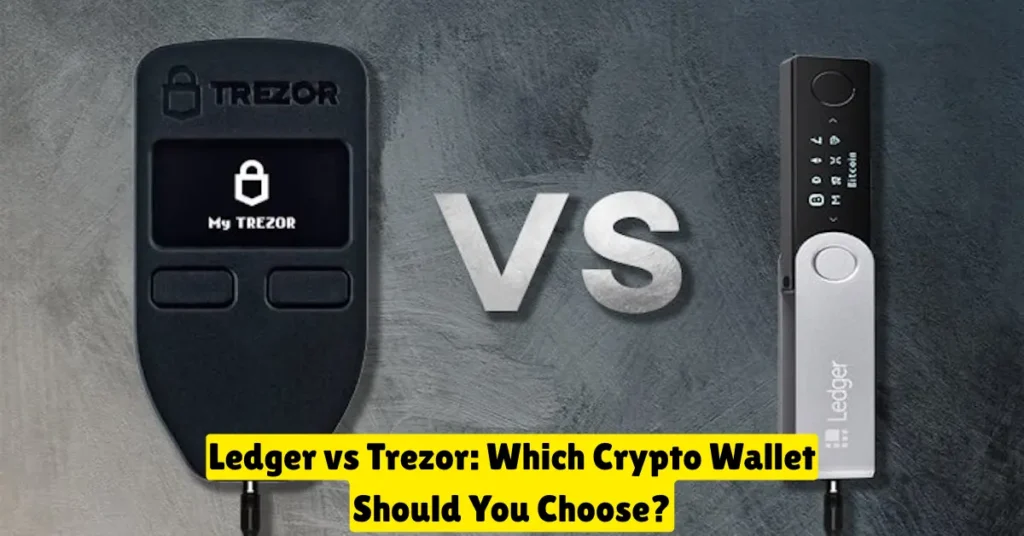Ledger vs Trezor:
In this guide, we’re diving into a detailed yet easy-to-understand comparison between two major names in the hardware wallet space: Ledger and Trezor. These wallets are built to keep your cryptocurrency secure, especially if you want full control over your assets without relying on online exchanges. While both are highly trusted and offer solid protection, they take different approaches when it comes to features, design, and security models. This guide will help you break down those differences clearly so you can figure out which one fits your needs best, whether you’re just starting or have been in crypto for years.
Ledger vs. Trezor: Security
When it comes to hardware wallets, security is the number one priority, and both Ledger and Trezor take it seriously, but they go about it in different ways.
Ledger uses a Secure Element (SE) chip, the same kind used in passports and credit cards. This chip is built to resist physical attacks and keeps your private keys locked inside, isolated from any outside connection. Ledger also runs a custom operating system called BOLOS, which adds another layer of protection by keeping apps separated and reducing risk from malicious code. However, Ledger’s firmware is partially closed-source, meaning not all of it is open for the public to review, which some users in the crypto community see as a drawback.
Trezor, on the other hand, takes a fully open-source approach. Its firmware, software, and hardware designs are all available to the public, which allows developers and security experts to inspect the code for any vulnerabilities. While Trezor doesn’t use a Secure Element chip, it relies on a strong PIN system, passphrase support, and transparent development to maintain trust. Many users appreciate this open model for its transparency and flexibility, even if it offers slightly less resistance to physical tampering.
In short:
- Ledger leans toward hardware-based, high-grade protection.
- Trezor focuses on open-source transparency and strong software-level defenses.
Both are highly secure, but your preference might depend on whether you value physical chip protection or open-source trust more.
Ledger vs. Trezor: Price Comparison
If you’re comparing Ledger and Trezor based on price, it’s important to not just look at the numbers but also consider what you’re getting for your money. Here’s a realistic breakdown:
Entry-Level Models
Trezor Model One: Around $69
- It’s one of the cheapest legit hardware wallets on the market.
- Great for beginners, but lacks support for some popular coins like XRP and ADA.
- No Secure Element chip.
Ledger Nano S Plus: Around $79
- Slightly more expensive, but supports more coins and tokens than Trezor One.
- Has a Secure Element chip, which adds physical security.
- No Bluetooth, but better value in terms of supported assets and future-proofing.
Verdict: For about $10 more, Ledger Nano S Plus gives you broader coin support and stronger security, it’s the better long-term value for most users.
Premium Models
Trezor Model T: Around $219
- Features a touchscreen, faster processing, and an easy-to-use interface.
- Fully open-source and ideal for privacy-focused users.
- Still no Secure Element, which some users see as a trade-off for transparency.
Ledger Nano X: Around $149
- Offers Bluetooth, a built-in battery, and support for more apps.
- Includes a Secure Element chip, but the firmware is partially closed-source.
- No touchscreen, but compact and travel-friendly.
Verdict: Ledger Nano X offers more practical features at a lower price. Trezor Model T is good, but you’re paying a premium mostly for the touchscreen and open-source appeal.
Bottom Line
- Tight budget? → Trezor Model One is cheap but limited.
- Best value overall? → Ledger Nano S Plus offers a strong mix of price and features.
- Premium features for less? → Ledger Nano X beats Trezor Model T on price-to-feature ratio.
- Want full transparency and a touchscreen? → Trezor Model T is for you, but it costs more.
Step-by-Step Guide: Ledger vs. Trezor
Step 1: Understand What a Hardware Wallet Is
Before diving into the comparison, it’s important to know what hardware wallets do.
They store your private keys offline, keeping your crypto safe from online hacks. Ledger and Trezor are two of the most trusted brands offering this type of cold storage.
Step 2: Get to Know the Brands
- Ledger is a French company, known for using Secure Element chips and its custom operating system (BOLOS).
- Trezor, made by SatoshiLabs in the Czech Republic, is famous for its fully open-source software and transparency.
Step 3: Compare Security Features
Ledger:
- Uses a Secure Element chip (strong protection against physical attacks).
- Partially closed-source firmware, which adds controversy but strengthens chip-level security.
Trezor:
- No secure chip, but uses open-source firmware for full transparency.
- Strong PIN and passphrase protection.
Which is safer?
Ledger offers stronger physical security. Trezor wins in terms of open-source trust and transparency.
Step 4: Check Device Design and User Experience
- Ledger Nano S Plus and Nano X: These are compact devices with a small screen and two buttons; the Nano X adds Bluetooth and a battery.
- Trezor Model One: Basic with two buttons; Trezor Model T: Color touchscreen, more modern and easier for beginners.
Which is easier to use?
Trezor Model T wins in terms of interface. Ledger Nano X is more travel-friendly.
Step 5: Compare Supported Cryptocurrencies
- Ledger supports more than 5,500 coins and tokens, including Bitcoin, Ethereum, XRP, ADA, SOL, and more.
- Trezor supports fewer assets by default, especially on the Model One (no XRP, ADA, etc.), but covers all major coins.
Need wide coin support?
Go with Ledger, especially if you deal with altcoins or newer tokens.
Step 6: Compare Software and Apps
- Ledger uses Ledger Live, a desktop and mobile app with built-in staking, buying, and swapping features.
- Trezor uses Trezor Suite, known for its clean interface and privacy tools (like Tor integration).
- Ledger Live is more feature-rich, but Trezor Suite is easier for privacy-conscious users.
Step 7: Look at Price vs. Features
| Model | Price | Key Features |
| Ledger Nano S+ | ~$79 | Secure Element, great coin support |
| Ledger Nano X | ~$149 | Bluetooth, battery, mobile use |
| Trezor Model One | ~$69 | Budget-friendly, but limited coin support |
| Trezor Model T | ~$219 | Touchscreen, open-source, premium design |
Best budget option: Ledger Nano S Plus
Best premium experience: Trezor Model T (if price isn’t a concern)
Step 8: Decide Based on Your Needs
- If you want maximum security with wide coin support, go with Ledger.
- If you value open-source software and a beginner-friendly interface, choose Trezor.
- If you’re on a budget, Ledger Nano S Plus offers the best balance of features and price.
- If you’re a privacy-focused user, Trezor Suite + open firmware might be more appealing.
Final Thoughts
Both Ledger and Trezor are excellent wallets with their own strengths. Your decision should be based on what matters more to you security type, transparency, coin support, or user experience.
Advantages and Disadvantages of Ledger and Trezor
Ledger: Advantages and Disadvantages
✅ Advantages
| Secure Element Chip: Offers strong hardware-based protection against physical attacks. |
| Wide Coin Support: Supports over 5,500+ crypto assets, including many altcoins and tokens. |
| Ledger Live App: Powerful companion app with built-in staking, swapping, and portfolio tracking. |
| Compact Design: Sleek and portable, especially the Nano X which includes Bluetooth and battery. |
| Strong Track Record: Used by millions globally and backed by a well-established company. |
❌ Disadvantages
| Partially Closed Source: Firmware is not fully open-source, which some in the crypto community view as a trust issue. |
| Complicated for Beginners: Interface can feel technical at first, especially for those new to crypto. |
| Data Breach Incident (2020): While no funds were stolen, Ledger’s e-commerce database was hacked, exposing user contact info this hurt its reputation. |
Trezor: Advantages and Disadvantages
✅ Advantages
| Fully Open-Source: Hardware, firmware, and software are transparent and publicly auditable. |
| User-Friendly Interface: Trezor Suite is clean and easy to navigate, ideal for beginners. |
| Touchscreen on Model T: Easier to operate, especially when entering PINs or passphrases. |
| Strong Privacy Features: Built-in options like Tor support in Trezor Suite. |
| No Bluetooth: No wireless connectivity may appeal to users who prefer a strict “offline” setup. |
❌ Disadvantages
| No Secure Element: Relies on software-based protections, which some users see as less secure against physical attacks. |
| Limited Coin Support on Model One: Popular coins like XRP and ADA aren’t supported. |
| Higher Cost for Premium Model: The Model T is more expensive than Ledger Nano X but offers fewer supported coins. |
FAQs: Ledger vs. Trezor
Which is safer Ledger or Trezor?
Both are very secure, but in different ways.
Ledger has a special chip (Secure Element) to protect your private keys from physical attacks.
Trezor doesn’t use that chip but is fully open-source, so its code can be checked by anyone for safety.
If you want physical security → Ledger.
If you want full transparency → Trezor.
Can I store Bitcoin, Ethereum, and other coins on both?
Yes, both support Bitcoin, Ethereum, and many popular coins.
However:
Ledger supports more tokens overall (over 5,500+).
Trezor Model One doesn’t support coins like XRP and Cardano (ADA), but Model T does.
Is Trezor easier to use than Ledger?
Yes, for most beginners, Trezor Suite is simpler and more beginner-friendly.
Ledger’s Ledger Live has more features, but can feel technical if you’re new.
Do I need to connect to the internet to use these wallets?
No, both keep your private keys offline.
You only connect the wallet to your computer or phone to sign transactions, but your keys never leave the device.
What happens if I lose my Ledger or Trezor device?
Don’t worry, you can recover your funds using your 24-word recovery phrase on a new device.
Just make sure you never share or lose that phrase.
Which one is better for mobile use?
Ledger Nano X is better for mobile it has Bluetooth and works well with smartphones.
Trezor has no Bluetooth, so it’s best for desktop/laptop use.
Can I stake crypto using Ledger or Trezor?
Ledger allows staking directly through Ledger Live for coins like ETH, DOT, and more.
Trezor supports staking too, but usually through third-party apps, not directly in Trezor Suite.
Which one should I buy if I’m on a tight budget?
Trezor Model One is cheaper (around $69), but with limited coin support.
Ledger Nano S Plus (around $79) gives you more features and coin options better value for money.
Is it safe to buy from Amazon or third-party sellers?
No, it’s not recommended. Always buy directly from the official Ledger or Trezor website to avoid tampered devices.
Can I use both wallets at the same time?
Yes! If you want, you can use Ledger for some assets and Trezor for others it’s all about your preference.
Conclusion
Both Ledger and Trezor are great choices for keeping your crypto safe it just depends on what matters most to you. If you want strong physical security and support for lots of coins, Ledger is a solid pick. If you prefer open-source transparency and an easy-to-use interface, Trezor might suit you better. No matter which one you choose, using a hardware wallet is a smart step toward protecting your digital assets.
Also read
- What is a Crypto Wallet and How Does It Work? – Coinsify
- 10 Crypto Terms Every Beginner Must Know – Coinsify
- What is Blockchain Technology – Complete Guide – Coinsify
- How to Buy Crypto Safely in 2025 – Complete Guide – Coinsify
- Bitcoin vs Ethereum: Key Differences Explained – Complete Guide
- Ultimate Blockchain Glossary: Learn Blockchain Terms Easily
- How to Buy Bitcoin Safely (Complete Beginner’s Guide)
- Top 10 Crypto Wallets for Beginners (2025 Edition)
- What is Cryptocurrency? A Beginner-Friendly Guide (2025)






